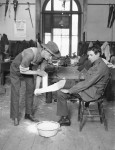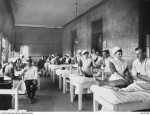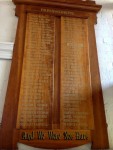RUNDELL, Ada Sophia
Ada Sophia Rundell was in the first contingent of masseuses (physiotherapists) sent overseas with the AIF. From 1915–1918, she worked in hospitals in England, France and England. Ada returned to Australia in 1919, working in Queensland where she married a terminally ill ex soldier in 1921. She ran her own masseur establishment in Ipswich and later in northern NSW.
Her story encompasses women and men who were prominent and pioneering in their professions: her father (civil servant and renowned philatelist), sister (dispensing chemist), cousin (first woman graduate in pharmacy in Victoria), and the masseur who trained her. Ada herself was prominent among Victoria’s first locally qualified massage practitioners.
Ada’s connection with East Melbourne comes from her attendance at St Peter’s Church, Eastern Hill. She is commemorated on the honour board listing women from the parish who served in the Great War.
***
Before the War
Ballarat-born Ada Sophia Rundell (1876–1963) was the only child of William Reeve Rundell (1848–1936) and his wife Agnes (Ada) (nee Manchester) (1848–1909).
Ada Sophia’s family on her mother’s side had come to the colony of Victoria in its very early days. Her grandparents Joseph Manchester and his wife Charlotte (nee Hall) had married in Warrington, Lancashire in 1833. Eight years later, in 1841, they arrived in Port Phillip from Plymouth on the emigrant ship Strathfieldsaye in August 1841, with three young children. They settled first in Melbourne, where Joseph established an iron moulder’s business and where Agnes (Ada Sophia’s mother) was born about 1850. They subsequently moved to Ballarat where both died, Joseph in 1867 and Charlotte in 1874.
The Rundell family, Ada’s father’s side, had settled in the Ararat and Ballarat areas. Ada’s paternal grandfather William Reeve Rundell had come from London with his wife Sarah Sophia. He was a shipwright, who came to the colony about 1855 followed the year after by his wife and their six year old son William. William senior became a prominent citizen in Ararat, active in local affairs from at least 1860. He died in 1876 a successful publican leaving an estate worth £2000 to his widow, naming his son, William Reeve Rundell, ‘Gentleman, Ballarat’, as executor.
A few months before his father’s death William Reeve Rundell junior had married Agnes Manchester, daughter of the later Joseph and Charlotte Manchester. The marriage was announced in the local paper (Ballarat Star, 29.9.1875, 5.10.1875). The couple’s only child Ada was born the following year, in 1876, in Ballarat.
In 1871, William had joined the Victorian Postal Department. In 1878 he was appointed to the Correspondence Branch of the GPO in Melbourne and from 1887 managed the branch. (see research on Rundell the civil servant and philatelist by Richard Breckon summarised on the Australian Postal History and Philately website, www.ausposthistory.com/articles/1985.php).
The Rundell family moved to Melbourne. Rate notices show that William the civil servant had a succession of addresses and properties: Hoddle St, Collingwood (1880–82), Moorabbin (1888–93), South Melbourne/Albert Park (1896–1922), and Caulfield (1906). During this time, his interest, expertise and reputation in philately grew, culminating in his appointment as a Fellow of the Royal Philatelic Society in London in 1915.
By the 1890s, Ada Rundell’s name appeared intermittently in the Melbourne social notes attending weddings and balls, and performing in amateur productions of opera and theatre. During that period, she was also establishing herself as a masseuse (physiotherapist) and was recorded as such on the 1903 electoral roll. She studied the techniques at St Vincent’s Hospital, Melbourne for twelve months under the direction of its honorary masseur, Alfred Peters (Ada Sophia Rundell, Service Record). Peters was well known and highly regarded as a masseur in Melbourne from the late 1880s. His patients included the governor-general, Prime Minister Alfred Deakin, leading members of the medical profession, and ‘a large number of ladies with special troubles’ (Prahran Telegraph, 27.1.1906, p3). He was also a key figure in the training and regulation of masseurs, and worked in various hospitals including St Vincent’s and Melbourne.
Rundell gained the Australasian Massage Association’s qualification which required both training in hospital and medical subjects taken at the University of Melbourne (Chipchase, L Galley, P Jull, G McMeeken, J Refshauge, K Nayler, M Wright, A (2006), 'Looking back at 100 years of physiotherapy education in Australia' Australian Journal of Physiotherapy' Vol. 52 - http://ajp.physiotherapy.asn.au/AJP/vol_52/1/AustJPhysiotherv52i1Chipchase.pdf). She was also honorary secretary of the Association’s Victorian chapter.
(Rundell’s interest in health was shared by other members of her family. Her mother’s sister Jane had married William Wollen, a dispensing chemist who owned stores in Ballarat and later Melbourne. Jane took over the business on his unexpected death in 1899, apprenticing their daughter Jane Beatrice Wollen. Jane Beatrice, cousin and contemporary of Ada Rundell, had the distinctions of being gold medallist and dux at the College of Pharmacy in 1897 and then the first woman to qualify as a pharmacist in Victoria (Australian Town and Country Journal, 7.10.1899, p14)).
In 1908 Ada visited England, perhaps with her father. She was reportedly unimpressd with the quality of training for masseuses there. She returned to Australia and for a time was a masseuse at the Children's Hospital in Melbourne.
When 39 year old Ada Rundell enlisted in 1915, she was charge masseur in the Melbourne Hospital’s outpatients department with fifteen years experience in the ‘execution of medical orders’. Her decision was not surprising: her mentor Alfred Peters was a vigorous proponent of massage treatments for wounded soldiers overseas and at home and a number of nurses from the Hospital had enlisted in the Australian Army Nursing Service. She also had the advantage of independence: her mother had died, her father had retired and was in sufficient health to travel and live overseas, and she had no siblings.
War Service
The politics and lobbying that resulted in the establishment and embarkation of the Australian Massage Service have been described in detail by Australian medical historian, A.G. Butler (‘The Australian Massage Service’, in A.G. Butler, Special problems and services: the official history of the Australian Army Medical Services in the war of 1914–1918, vol. III (Canberra: Australian War Memorial, 1943; also online at awm.gov.au).
Rundell was in the first contingent of six masseurs and masseuses who left Australia on service, in August 1915. Like other masseuses she held the rank of staff nurse. The group was divided in two: half were stationed in Egypt to treat wounded troops from the Dardanelles campaign, the others continuing to England to work in hospitals there.
Rundell was posted initially to 1AGH located in the Heliopolis Hotel in Cairo. For all its overcrowding, the constant influx of wounded troops and the distraction of the contretemps between the officer commanding the hospital and the matron (Melbourne Hospital’s Jane Bell), 1AGH must have seemed like luxury in comparison to 3AGH where Rundell was sent in October 1915 (Rundell, Service Record [NAA]).
3AGH was stationed on Lemnos Island, far closer to the Dardanelles than Cairo. Rundell escaped the initial and now notorious chaos which greeted Matron Grace Wilson and her nurses when they had arrived on Lemnos several months earlier. Under Wilson’s direction, primitive conditions had been replaced by considerable organization and order in the care of sick and wounded troops. The winter weather and wind were fearsome, some nurses succumbed to ‘Lemnitis’ (dysentery), and wards were tented but Rundell is likely to have performed her massage treatments in reasonable conditions.
3AGH left Lemnos in January 1916 after the withdrawal of Australian troops. Rundell returned to 1AGH in Cairo for several months and then embarked with the unit for the Western Front in April 1916. In the weeks before 1AGH could accept patient in its new location on the racecourse at Rouen, its nurses were ‘lent’ among the other numerous hospitals in the area. Rundell spent a brief period at 6 General Hospital, where she no doubt encountered the far more British ways of military nursing and hospital culture. She rejoined 1AGH after leave in Paris – no doubt an exciting and completely novel experience for her.
Apart from a stint at 8 General Hospital on the outskirts of Rouen, Rundell seems to served at 1AGH for several months, until January 1917. She would have experienced some of the wicked winter freeze of 1916-17 (her second successive freezing winter), when the water pipes at 1AGH froze and burst, fresh food was in short supply, and casualties poured in from the Somme offensive. The hospital’s bed capacity soared from 200 to 800 by December 1916. Most patients were wounded (e.g. by gun shot, shrapnel or gas) rather than sick, and the majority were evacuated to England after several days. Providing massage treatments must have been all but impossible in the context of an unceasing round of admissions, treatments and preparation for transport to England, convalescent camps, other hospitals or return to their unit. In her time there, the average length of stay of patients fell from seven days to three days, indicating the degree of churn (1AGH, War Diary [NAA]).
In January 1917, Rundell was transferred from 1AGH to 2AAH in Southall near London, an environment far more conducive to effective massage treatment than 1AGH could be. 2AAH specialized in treating patients with single and multiple limb amputations, designing manufacturing and fitting prostheses, and preparing the troops for the return voyage to Australia. The 2AAH massage staff focused on ‘promoting nutrition in the tissue of amputation stumps’ (Butler, p610).
The 2AAH monthly war diary (2AAH, War Diary [AWM]) from October 1917 included reports from the x-ray and massage department. The first (October 1917) noted the great variety of cases treated and successes but commented that the ‘limited accommodation and meagre amount of apparatus’ meant that less than half those requiring treatment received it.
There was another issue affecting the massage department: preference for male masseurs over female masseuses. 2AAH had two masseuses and one masseur. The report for March 1918 stated ‘it is now proposed to do all the massage with men and for this purpose two suitable C1 men are to be picked out’ (2AAH, War Diary, March 1918). Rundell and the other masseuse were ‘warned for transport duty’.
Rundell resigned (‘terminated her appointment’) in early April 1918 before she could be despatched on a transport ship. (One document in her service record lists her as discharged as permanently unfit but this seems an error.) Her father William was living in England, the probable reason she remained there another year even though it meant relinquishing the right to a paid passage home. Highly experienced she may have worked privately as a masseuse. She sailed for Melbourne in April 1919 on the Castralia which carried a small group of women and children as well as returning troops. Vera Deakin OBE, legendary for her work with the Australian Red Cross, was a fellow passenger in 1st Class. Her father William reached Melbourne later that year.
After the War
Ada Rundell did not remain in Melbourne after her return. She was 45 years old. In 1920, she was senior masseuse at No 27 AAH (Rosemount Repatriation) in Brisbane (Rundell, Service Record). Specialising in orthopaedics, Rosemount employed over 20 massage staff and conducted more than a thousand treatments a week (Queenslander, 8.11.1919, p5).
In June 1921, Ada married Alfons Sten. Sten, of Swedish birth but naturalised in 1912, had enlisted in the AIF in May 1915, and served in Egypt and then on the Western Front. He had been attached to 1AGH in Rouen France in 1916, where he may very well have met Ada. In 1917, he had been diagnosed with tuberculosis, hospitalised and sent back to his home state of Queensland for discharge (Alfons Sten, Service Record [NAA]). Whether Ada moved to Queensland because of Alfons, seriously ill and fourteen years her junior, is unknown.
They had been married just two years when Alfons died on 7 July 1923 (Queensland Times, 9.7.1923, p4). The couple had moved to Ipswich, where Ada had opened a massage practice that had won favour in the local press for its bright atmosphere, up-to-date equipment and experienced masseuse (Queensland Times, 7.3.1922, p4). Alfons had been in receipt of a repatriation pension; as his widow, Ada received a repatriation benefit and (on request) a memorial plaque and scroll honouring Alfons (Alfons Sten, Service Record; Ada Rundell, Service Record).
Electoral rolls show that on his return from England, William Rundell lived near or usually with his daughter Ada: in Brisbane, Ipswich, then in Ashfield, a Sydney suburb, where William died in 1936.
After the death of her father, Ada returned to Queensland where she lived for the remainder of her life in Wynnum, a Brisbane suburb. She died in 1963.
Thanks to
* Faithe Jones for reference to Ada Rundell's photograph in Table Table 16.9.1915 and her precise date of death,
* Barbara Cytowicz, archivist at St Vincent's Hospital Melbourne, for references to early massage/physiotherapy training in Victoria and
* Joan McMeeken for information on Ada's trip to England in 1908.
Janet Scarfe
Adjunct Research Associate, Monash
26.6.2016; updated 10.8.2017.
Can you help?
Can you correct or provide more information about this person?
Or are you able to help with this history project?
- Family stories and records including photos, documents and memorabilia?
- Stories or information in books, newspapers and on-line?
- Memorial plaques in churches and public places?
- War memorial, church, national and state archives?
If so, please Contact the East Melbourne Historical Society.




